The Wheelchair Guide
Your Wheelchair and Mobility Scooter Resource
A Look at the Advantages of the Mobility Scooter
Thursday, July 22nd, 2010
Elderly people who have difficulty getting around often find that using a wheelchair is not the optimal solution, especially since manual wheelchairs can require a lot of physical strength to use. Instead, a mobility scooter is often a better choice and is usually considerably less than an electric wheelchair.
Mobility scooters, like wheelchairs, have been around for some time, but the first electric mobility scooter can be traced back to the 1960′s. Since then, there have been a number of improvements in their design and dependability.
An Electric Mobility Scooter, or adult scooter, is a motorized device used to help make it easier for someone to get around. The base of the device is elongated and has a chair positioned towards the rear and handlebars on the front. The handlebars, which are referred to as the tiller, extend from the front of the electric scooters base and can be adjusted to bring them closer or farther from the user. In addition to controlling the direction of the scooter, the tiller can also control acceleration and braking, as well as controlling any other extras, such as running lights.
One of the big differences between mobility scooters and electric wheelchairs is the tiller. On an electric wheelchair, an armrest control is usually used to move the device and there is nothing in front of the users legs. However, on a mobility scooter, the tiller is located on the front of the users legs, which makes it impossible to drive the mobility scooter directly up to a table or desk. As a result, the target market for a wheelchair and scooter differs in that mobility scooters are primarily intended for people who can walk for short distances, but have trouble doing so.
While there are many types of mobility scooters, many much less expensive than others, most are designed to work well both indoors and outdoors. There are several considerations though, such as tire size, ground clearance, and speed, which help determine if the scooter will work well outdoors. The number of tires can also have an effect, with 4-wheel mobility scooters offering more stability when used outdoors.
3-Wheel Mobility Scooters, on the other hand, offer the advantage of being more maneuverable, as they have a smaller turning radius. So, for indoor use, a 3-wheel scooter may be preferable. Of course, this extra maneuverability comes at the cost of stability and weight support, so it is important to determine what type of scooter will work best for your individual needs.
There are also several types of scooters that are designed to fit special needs. For example, heavy duty scooters are designed to support more weight and preform better outdoors. Travel scooters, on the other hand, are essentially on the opposite side of the spectrum. Travel scooters are designed to be as lightweight as possible, so they can be transported easily without a scooter lift. They have fewer features and extras to help reduce weight, typically being designed to be broken down into several easy to manage pieces.
A Brief Look At The Three Types of Mobility Scooters
Saturday, June 19th, 2010
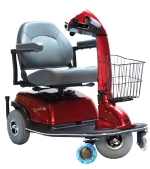 While seniors are not the only group of people to use mobility scooters, they are much more common among the elderly and are a powerful tool for patients who are only partially ambulatory. Mobility scooters are designed to provide supplemental walking assistance to the mobility challenged, safely transporting their rider over both indoor and outdoor terrain.
While seniors are not the only group of people to use mobility scooters, they are much more common among the elderly and are a powerful tool for patients who are only partially ambulatory. Mobility scooters are designed to provide supplemental walking assistance to the mobility challenged, safely transporting their rider over both indoor and outdoor terrain.
Mobility scooters, which are also called electric scooters or adult scooters, have been around for about fifty years, but did not really start to gain popularity until the 1980′s. Since then, names like the Rascal have become household names and many people take advantage of this powerful type of home medical equipment.
There are many brands of mobility scooters and several distinct categories. Understanding how these different types of mobility scooters work and how they are classified can make buying a mobility scooter much easier, as well as helping to narrow down the available choices.
Travel Scooters
Travel Scooters are often the least expensive type of mobility scooter and are designed to be taken apart into several managable pieces. Many include special clips that allow the scooter to be broken down quickly, often with only one hand. When dissasembled, the indivudal pieces of the travel scooter are lightweight and easy to move, with the heaviest piece often weighing less than 30 pounds.
Being able to take the scooter apart makes it much easier to transport, as it can be placed in the trunk of a car, rather than requiring a special scooter lift be installed on the vehicle.
While travel scooters can be a great choice in some cases, they usually lack a lot of the features other mobility scooters have. This is because in order to reduce weight, pretty much anything not related to safety or required for functionality is removed. As a result, travel scooters usually support less weight, have a shorter per-charge range, and are not quite as durable as other mobility scooters.
For everyday use, a travel scooter is often not the best choice, but they can make it much easier and less expensive to transport the device.
Traditional Mobility Scooters
Traditional Mobility Scooters are usually designed to be broken down in a manner similar to that of a travel scooter, but the individual pieces are not quite as lightweight or easy to manage. However, traditional scooter have many other features, both safety related, such as improved suspension, lighting systems, and larger weight capacities, as well as comfort related.
Typically a vehicle scooter lift is required to transport the mobility scooter, which has a significantly higher range than travel scooters.
Heavy Duty Mobility Scooters
Heavy Duty Mobility Scooters, as the name implies, are the Mack Truck of mobility scooters. They are much larger than other types of mobility scooters, making them more difficult to transport, but have a much higher weight rating and are designed to preform well across all types of terrain, including off-road.
They feature larger wheels, a higher ground clearance, reinforced bumpers, and many other features designed to make the device as rugged as possible. Heavy Duty Electric Scooters also have a larger per-charge range and can support a much higher weight capacity than other mobility scooters, as well as having many creature comforts, like a large comfortable captains chair.
Mobility scooters, while excellent for outdoor use, do tend to be pretty large, so they are not always the best choice for tight quarters in a home. Like other types of mobility scooters, most heavy duty mobility scooters can be broken down into several pieces, but it is not uncommon for the lightest piece to be over 100 pounds. So, it is usually not practical to break them down for transportation, at least not for daily transport.
What are Mobility Scooters?
Wednesday, May 5th, 2010
Limited mobility and difficulty getting around are two common problems for the elderly. Often, conditions such as arthritis result in difficulty walking, especially over long distances, which can make keeping up with the grandchildren impossible. This is one of the reasons that many seniors use mobility scooters, which provide a motorized base that can make it possible to travel miles and miles, with only the push of a button.
Mobility scooters are similar to electric wheelchairs, at least in regards to functionality, and electric scooters were first developed in the 1960′s, which is around the same time that the first electric wheelchair was developed. However, while the functionality of a power chair is similar to that of an electric mobility scooter, they feature a design that is much different. This difference in design is in part because where electric wheelchairs are designed for those who can not walk at all, mobility scooters are intended to be provide a supplement to walking.
Most mobility scooters feature a long base, with a chair mounted towards the rear of the base, above the electric motor and batteries. A set of handlebars, called a tiller, is installed on the front of the electric scooter and is used to control the direction and speed of the scooter. As a result, however, it is not possible to drive a adult scooter directly up to a table or desk the same way you can with a wheelchair.
There are a number of different types of electric scooters, with Pride Mobility and Golden Technologies being two of the more well known brands. Both of these companies offer a large line of mobility scooters that are intended to fill different needs, with Pride Mobility Scooters and Golden Mobility Scooters being some of the most reliable and well made ones around. Of course, there are many other manufacturers of adult scooters, including ShopRider, who offers several lines of low priced electric scooters.
With the many different models, manufacturers, and options available, it is easy to become overwhelmed when you begin shopping for a mobility scooter, but they can be classified by the number of wheels, weight capacity, and function. Understanding these classifications and their advantages can make buying a mobility scooter, even when buying online, much easier.
What is the Difference Between Travel Scooters, Standard Scooters, and Heavy Duty Scooters?
The intended function of the scooter is one of the most common ways that these devices are classified and if you visit any reputable online retailer, you will surely see an option to sort them by travel scooters, standard scooters, and heavy duty scooters.
A travel scooter is a mobility scooter that is designed to be as lightweight as possible and be broken down into several easy to manage pieces. As a result, it is seldom necessary to use a scooter lift to transport a travel scooter, as it can be quickly and easily disassembled, with the heaviest piece usually weighing less than 30 pounds. However, to cut weight, these scooters have reduced features and a much lower weight capacity, as well as often being less powerful and having a shorter range. This means a travel scooter is often not the best choice for an everyday driver.
Heavy Duty Scooters are on the other end of the scale, designed to support the most amount of weight and be driven over much rougher terrain. They usually are much larger, featuring a big captains chair, higher top speeds, larger tires, and many other features, such as improved bumpers and reinforced structures. A heavy duty scooter can be a great choice for those who like spending time outdoors, as they are the most versatile and can be driven over most types of ground. This versatility comes at a cost, however, as their large size means it is necessary to use a scooter lift to transport them and that they are not always as well suited for the tight corners of a home. Heavy duty scooters are also the most expensive type of scooter.
Standard Mobility Scooters form a nice middle ground, offering improved weight and power capacities over a travel scooter, while being smaller and easier to manage than a heavy duty scooter. For everyday use, a standard scooter is usually a good choice, as it has a long range, is very reliable, and includes a lot of features that are taken out of a travel scooter to reduce weight.
Why Do Some Mobility Scooters Have 3 Wheels and others 4?
The number of wheels, either three or four, a mobility scooter is another way that they are classified. Three wheeled mobility scooter are lighter in weight, so many travel scooters use a three wheel design. Three wheel scooters are also more maneuverable, as they have a smaller turning radius.
Four wheel scooters are a little heavier than other scooters and not quite as maneuverable, but because the weight is more evenly distributed, they tend to be more stable. As a result, most heavy duty scooters are four wheeled.
Senior Mobility Scooters Explained
Sunday, February 28th, 2010
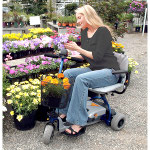 Wheelchairs are a powerful asset to those who are unable or have difficulty walking, but for seniors who are able to walk for short periods of time, the mobility scooter is often a better choice. Mobility scooters are similar to wheelchairs in functionality, but use a different design and typically cost less than an electric wheelchair.
Wheelchairs are a powerful asset to those who are unable or have difficulty walking, but for seniors who are able to walk for short periods of time, the mobility scooter is often a better choice. Mobility scooters are similar to wheelchairs in functionality, but use a different design and typically cost less than an electric wheelchair.
Mobility scooters, which are often called adult scooters, have a much longer base that an electric wheelchair does. The base, which is made out of molded plastic, has one set of wheels in the front and another in the back, although many are three wheeled, so only have one wheel in front. The user sits in a chair that is positioned more towards the rear of the scooter and a tiller, which is similar to a set of handlebars, extends from the front of the scooter and is used to control it.
The tiller usually allows the scooter to not only be turned, but also contain a key locking mechanism, speed controls, and is used to control any other accessories, such as horns and lighting. Many also come with a basket that is attached to the front of the scooter, although even those that do not can be fitted with an aftermarket basket.
Mobility scooters utilize rechargeable batteries, which mean unlike gasoline scooters, a mobility scooter can be used indoors and outdoors. The per-charge range varies by model, with most allowing for at least a 4 mile per-charge range.
Travel scooters, which are designed to be very lightweight, can be taken apart into several pieces, with the heaviest piece usually not weighing over 30 pounds. This way, the scooter can be taken apart and placed in the rear of a vehicle, without having to use a scooter carrier or lift. Of course, to reduce weight many of the comfort features are removed and travel scooters usually have a lower weight capacity and per charge range.
Heavy duty scooters, on the other hand, are almost the complete opposite of a travel scooter. They are designed with performance in mind and have a much higher weight capacity and can often travel over 20 miles on a single charge. With larger tires and higher ground clearance, as well as reinforced bumpers, heavyduty scooters are also have much better performance outdoors and across rugged terrain. However, since they are so much larger in size, it is necessary to use a vehicle scooter lift to transport them. Even though they, like most mobility scooters, can be disassembled into several pieces, the individual pieces are much heavier than those of travel scooters.
The Adult Scooter is often a lower cost alternative to the electric wheelchair. However, due to its design, a mobility scooter can not be driven directly up to a table or desk in the same way a wheelchair can. As a result, most people who use mobility scooters can walk for short periods of time. There are many wheelchair users though that invest in a heavy duty scooter for outdoor use, as they can be driven almost anywhere.
What Are Mobility Scooters?
Tuesday, February 9th, 2010
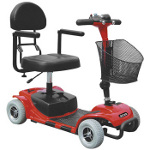 Moving around is often quite difficult for the elderly, especially among seniors who have arthritis. Since using a wheelchair can be quite strenuous, it is often not a good choice for seniors, especially those who intend to travel away from the home.
Moving around is often quite difficult for the elderly, especially among seniors who have arthritis. Since using a wheelchair can be quite strenuous, it is often not a good choice for seniors, especially those who intend to travel away from the home.
Mobility scooters provide a nice middle ground between an electric wheelchair and a regular wheelchair, while also often being better suited for outdoor use. This is because, in most cases, a mobility scooter is significantly less expensive than an electric wheelchair, so often the cost of a scooter vs a wheelchair is a big selling point.
The mobility scooter is not exactly a new medical device, with the first models being developed during the nineteen-sixties. However, it would not be until about twenty years later, during the nineteen-eighties, when their popularity really took off.
While the functionality they offer is similar to that of an electric wheelchair, adult scooters have a different design, with a longer base that has a set of handlebars in the front and a seat towards the rear. The electric scooter is controlled using the handlebars at the front, which is called a tiller, usually allows the scooter to not only be turned, but also the speed regulated and the control of any extras, such as lighting or horns.
Since the tiller is located in the front of the electric scooter, it can not be driven directly up to a table the same way you would an electric wheelchair. Instead, it is either necessary to exit the scooter and transfer to a chair or to drive the scooter up parallel to the table. To make it easier to transfer out of the scooter, the chair can be turned and some even come with automatic lifting chairs as well.
Different Types of Mobility Scooters
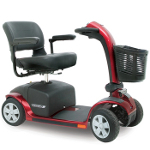 There are many different models of mobility scooters, but they can typically be classified as either a travel scooter, heavy duty scooter, or standard scooter.
There are many different models of mobility scooters, but they can typically be classified as either a travel scooter, heavy duty scooter, or standard scooter.
Heavy Duty Scooters are the most powerful and are designed to support more weight, as well as for outdoor use. As a result, they usually have reinforced bumpers, larger wheels, stronger suspension, and many other features. However, as they are much larger than other types of scooters, a heavy duty scooter usually requires scooter lift to transport the scooter away from home, as well as not being as well suited for tight quarter indoor use.
Travel Scooters are basically the direct opposite of a heavy duty scooter, with the focus being on making the scooter as lightweight as possible, so that it can be easily transported. This means they have fewer features and everything, from the tiller to the seat is designed to be as light as possible. A travel scooter can be taken apart easily and each individual piece is intended to be able to be easily lifted into a vehicle. Since a travel scooter is so light, they usually have the shortest per-charge range and a much lower weight capacity.
Standard scooters form the middle ground, trying to blend the right amount of features, with the overall weight of the device. As a result, they are not as easy to transport as a travel scooter, but have a larger range, more comfortable seating, and generally a number of comfort features. Usually they can be broken down into more manageable pieces, as can heavy duty scooters, but they are still much heavier than a travel scooter.
A Word About Wheels
Another way that mobility scooters are classified is by the number of wheels they have, specifically four wheel mobility scooters and three wheel mobility scooters. In the case of 4-Wheeled Scooters, there is a more even distribution of weight across the base of the scooter. This makes them more stable, as well as being better suited for larger weight capacities and outdoor use. For this reason, most heavy duty scooters are four wheeled.
Three wheeled scooters are not as stable, but they do have a smaller turning radius than four wheeled scooters. As a result, this makes them a better choice for indoor use. Also, since the front axle is smaller, they are also lighter, so many travel scooters use a three wheel design.
Mobility Scooter Buyers Guide and FAQ
Monday, January 18th, 2010
 Among the elderly, the mobility scooter provides one of the most valuable services for those who have difficulty walking. There are a number of different mobility scooter models available, as well as a number of different manufacturers, so it is sometimes overwhelming finding right mobility scooter, but when you know a little bit about them, it is not as difficult as it might seem.
Among the elderly, the mobility scooter provides one of the most valuable services for those who have difficulty walking. There are a number of different mobility scooter models available, as well as a number of different manufacturers, so it is sometimes overwhelming finding right mobility scooter, but when you know a little bit about them, it is not as difficult as it might seem.
Mobility scooters have been around for over forty years, but it was not until the eighties that they really became popular and more common place. Today, mobility scooters, which are sometimes called electric scooters or adult scooters, are very popular and provide a lower cost alternative to an electric wheelchair.
Below, you will find the answers to some frequently asked questions about these extremely useful senior mobility vehicles.
Table of Contents
- What Are Mobility Scooters?
- Where Can I Use My Mobility Scooter?
- What is the Difference Between Three Wheel vs Four Wheel Scooters?
- What Type of Speed and Battery Life Should I Expect?
- What Extra Features and Accessories Are Available?
- What Are Travel Scooters?
- What is a Heavy Duty Scooter?
- Who Are Some Popular Mobility Scooter Manufacturers?
What Are Mobility Scooters?
A mobility scooter is an electric vehicle that is used to carry a single occupant, typically both indoors and outdoors. They are similar to electric wheelchairs, except mobility scooters have a longer base, with the captain’s chair positioned more towards the rear of the scooter. A set of handlebars, called a tiller, is attached to the front of the scooter, which allows the scooter to be turned, as well as regulating speed, braking, and controlling the extra features, such as the horn and lights.
The main difference between a mobility scooter and an electric wheelchair is the addition of the tiller. Electric wheelchairs typically use a joystick control that is mounted to the side of the wheelchair’s arm rest, which allows the wheelchair to be driven directly up to a table or bench. Mobility scooters, on the other hand, are controlled by the tiller, which prevents it from being driven directly up to a table. Mobility scooters also usually cost a good deal less than electric wheelchairs.
Where Can I Use My Mobility Scooter?
Most mobility scooters are designed to be used indoors, as well as outdoors over tightly packed terrain. However, if you intend to use the scooter over loosely packed ground, such as dirt or sand, you may need to invest in a more durable mobility scooter. However, when driving over uneven terrain, even if it is tightly packed, it is important to be very careful in order to prevent the scooter from tipping over.
One thing to keep in mind is how much room you have indoors, as some mobility scooters are more maneuverable than others. The manufacturer will provide a turning radius, which describes the smallest space the scooter can turn it.
There are also environmental factors that can reduce the performance of the scooter. For example, driving a mobility scooter uphill will cause the battery to wear out quicker than when it is driven on flat terrain. Similarly, the weight of the rider also affect the per-charge range of the scooter, with a heavier rider reducing the range of the mobility scooter.
What is the Difference Between Three Wheel vs Four Wheel Scooters?
One way that mobility scooters are classified is by the number of wheels that they have, specifically, either three wheeled mobility scooters or four wheeled mobility scooters.
In general, a four wheeled mobility scooter will provide better stability and higher weight support, where a three wheeled mobility scooter will be more maneuverable. This is because the four wheeled scooter more evenly distributes the weight of the rider between the front and back of the scooter.
What Type of Speed and Battery Life Should I Expect?
Both the top speed and the per charge range, varies by model. However, most travel between 4-5mph and have a per charge range of between 8-10. There are, of course, exceptions to this, with some mobility scooters traveling over 10mph for distances of over twenty miles.
One thing to keep in mind when considering battery life, is that the amount you use the scooter will have a direct relation on how often you have to charge it and how long the battery lasts. For instance, someone that only uses their scooter once every few days probably would not need to charge the scooter everyday. On the other hand, someone who drives several miles each day on their scooter would probably have to charge it each night.
Environmental factors also play a part in battery life, with things like driving up hill or carrying extra weight causing the battery to wear down faster. Batteries do need to be replaced and depending on how much the scooter is used, this could mean replacing it each year or every few years.
What Extra Features and Accessories Are Available?
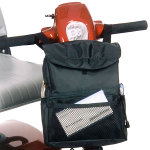 There are a number of extra features available for most scooters, which include things like cane holders, oxygen racks, and visibility flags. Often, some of these can be purchased cheaper at a bike store, as is the case with side mirrors and visibility flags, than you would be able to purchase them from a manufacturer. So, it is important to determine if it is a scooter specific accessory, which will only work with a specific model, or if it is an accessory that is generic, which will work with any type of scooter.
There are a number of extra features available for most scooters, which include things like cane holders, oxygen racks, and visibility flags. Often, some of these can be purchased cheaper at a bike store, as is the case with side mirrors and visibility flags, than you would be able to purchase them from a manufacturer. So, it is important to determine if it is a scooter specific accessory, which will only work with a specific model, or if it is an accessory that is generic, which will work with any type of scooter.
There are a number of bags that are also available, including armrest bags, under the seat bags, and back of the seat bags. Trays are also popular, which make it easier to eat, write, or work on a computer while using the scooter.
What Are Travel Scooters?
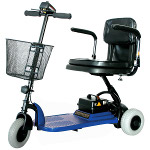 Travel scooters are lightweight mobility scooters that are designed so that they can be quickly and easily dissembled into several easy to manage pieces. Often, they use quick release snaps that can be activated with a single hand and the heaviest piece weighs only around 30 pounds.
Travel scooters are lightweight mobility scooters that are designed so that they can be quickly and easily dissembled into several easy to manage pieces. Often, they use quick release snaps that can be activated with a single hand and the heaviest piece weighs only around 30 pounds.
The advantage of a travel scooter is that it can be stored quickly and easily in a plane, car, or other vehicle, without having to use a scooter lift. Most travel scooters are three wheeled, as this helps reduce weight. However, they are also usually bare bones in regards to included features, which helps to reduce weight. Travel scooters are also not able to travel as far on a single charge, nor are they able to support as much weight or preform as well outdoors as other mobility scooters.
What is a Heavy Duty Scooter?
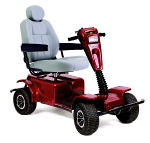 A Heavy Duty Scooter is one that is designed to support more weight and preform better outdoors than a regular mobility scooter. They typically are four wheeled, which provides the most stability and use air filled, pneumatic, tires, which improve suspension and off road performance. Heavy Duty Scooters are intended for outdoor use, so have larger wheels and a higher ground clearance, as well as having reinforced bumpers, extra large seats, and a number of other extra features.
A Heavy Duty Scooter is one that is designed to support more weight and preform better outdoors than a regular mobility scooter. They typically are four wheeled, which provides the most stability and use air filled, pneumatic, tires, which improve suspension and off road performance. Heavy Duty Scooters are intended for outdoor use, so have larger wheels and a higher ground clearance, as well as having reinforced bumpers, extra large seats, and a number of other extra features.
While Heavy Duty Mobility Scooters are well suited for outdoor use, have a very large range, and a much higher weight capacity than other scooters, they are much bigger than most other types of scooters. As a result, a heavy duty scooter might not work well inside of a smaller home and to transport it, a scooter lift would be needed.
Who Are Some Popular Mobility Scooter Manufacturers?
There are a number of mobility scooter manufacturers, but Pride Mobility and Golden Technologies are probably the most well known, with both companies having manufactured home medical equipment for over twenty years. While Pride Scooters and Golden Scooters are the most recognized, they also tend to cost more than other lesser known brands.
ShopRider is a company that offers a number of mobility scooters, which are typically priced lower than Golden Mobility Scooters and Pride Mobility Scooters.
Ultimately, if you decide not to go with one of the major brands, it is important to check for consumer reviews of the company and their scooters. Also, ensure that they provide a warranty for their scooter, which is similar to the length of a warranty on a name brand scooter. There are a number of very cheap scooters out there, but they will often have a very limited warranty, which means they should usually be avoided.
What Are Heavy Duty Mobility Scooters?
Monday, January 11th, 2010
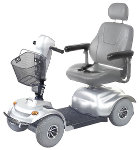 Mobility Scooters are often used by seniors and are electric scooters designed to help make it easier to get around. Using rechargeable batteries, these adult scooters can be driven indoors and outdoors, making life easier for who are able to walk, but only with difficulty. There are many types of mobility scooters, but one of the most powerful and fun to drive types is the Heavy Duty Mobility Scooter.
Mobility Scooters are often used by seniors and are electric scooters designed to help make it easier to get around. Using rechargeable batteries, these adult scooters can be driven indoors and outdoors, making life easier for who are able to walk, but only with difficulty. There are many types of mobility scooters, but one of the most powerful and fun to drive types is the Heavy Duty Mobility Scooter.
As the name implies, a Heavy Duty Mobility Scooter is very rugged, has a heavier weight capacity, and can be driven in areas where other types of mobility scooters could not. They have larger wheels and often reinforced shocks, making them well suited for off road terrain. It is also common for heavy duty mobility scooters to have reinforced bumpers, to protect against impacts and things like brush, which might be experienced when driving the scooter outdoors.
Pneumatic Tires are also almost always used, which means the tires are filled with air instead of being a solid piece of rubber. This helps to improve traction, making the scooters preform better on loosely packed dirt or other outdoor terrain.
Most Heavy Duty Scooters use a four wheel design, as this provides the most stability, but some three wheeled heavy duty scooters are available. The Three Wheel Models will have a better turning radius, at the expense of reduced stability.
To give you an idea of the difference in weight capacity between a regular mobility scooter and a heavy duty mobility scooter, most regular adult scooters support between 250 and 300 pounds. A heavy duty scooter, on the other hand, will usually support between 400 and 500 pounds.
Not only are heavy duty scooters able to support more weight than other electric scooters, they also have a significantly higher top speed and battery life. For example, it is common for a heavy duty scooter to travel more than 25 miles on a single charge at speeds over 5 mph. This is opposed to most traditional electric scooters, which have a range of around 10 miles or less.
Heavy Duty Electric Scooters also have a number of extra features to make them more comfortable, such as improved seats with head support and even sometimes carpeting on the base of the scooter.
Disadvantages of Heavy Duty Mobility Scooters
One thing to keep in mind is that Heavy Duty Mobility Scooters are usually the most expensive type of mobility scooter. They usually start at around $2500 and can exceed $5000, depending on the model and features.
Also, since heavy duty mobility scooters are so much larger and heavier they are not as easy to transport. Most of those who purchase a heavy duty mobility scooter invest in a scooter lift for their vehicle, which makes it easier to transport.
Heavy Duty Scooters also are not as maneuverable as other smaller electric scooters, so will not always be the best choice for use indoors.
Popular Heavy Duty Mobility Scooter Manufacturers and Models
Pride Mobility, Golden Technologies, and ShopRider all offer at least one Heavy Duty Mobility Scooter.
There are several different models of heavy duty scooters, but the ShopRider Xl4 Deluxe(#889XLSBN,) Golden Avenger(#GC-541,) and Pride Hurricane(#PMV5001) are some of the more popular models of heavy duty scooters.
A Closer Look at the Mobility Scooter
Saturday, December 26th, 2009
 Mobility scooters are not exactly new devices and have been around for some time, with the first models first being developed around forty years ago. Up until the nineteen-eighties the cost of mobility scooters, and for that matter electric wheelchairs, was often rather prohibitive, making the device not as common. However, due to increased competition and improved manufacturing techniques, mobility scooters are relatively inexpensive today and are extremely popular among the elderly.
Mobility scooters are not exactly new devices and have been around for some time, with the first models first being developed around forty years ago. Up until the nineteen-eighties the cost of mobility scooters, and for that matter electric wheelchairs, was often rather prohibitive, making the device not as common. However, due to increased competition and improved manufacturing techniques, mobility scooters are relatively inexpensive today and are extremely popular among the elderly.
A mobility scooter is a motorized device that is used to carry a single person around their home or as they complete daily activities. Using rechargeable batteries, many mobility scooters are able to support an individual weighing more than 300 pounds over distances exceeding 10 miles on a single charge.
Differences Between Electric Wheelchairs and Mobility Scooters
The function and manufacture of mobility scooters is actually quite similar to that of an electric wheelchair, but the actual design of these two devices is usually quite different.
Since an electric wheelchair is intended for constant use by its owner, it is designed so that it can be driven directly up to a table or desk, with its captain’s chair being positioned atop a small plastic base.
Mobility scooters, on the other hand, are designed more as a walking supplement and are usually used by those who are able to walk on their own for short periods of time. So, a much longer plastic base is used, with a set of handlebars extending from the front of the base.
The handlebars, or tiller as it is usually referred to, make it impossible for a mobility scooter to be driven directly up to a table or desk in the same manner as a wheelchair could be. They also usually contain headlights, turn signals, and other gauges to indicate things like battery strength.
Due to the larger wheelbase of a mobility scooter in relation to an electric wheelchair, they are often better suited for uneven terrain and outdoor conditions.
Types of Mobility Scooters
There are actually quite a few different types of mobility scooters. There are a number of ways to classify them, such as by their range and weight capacity, as well as their intended use.
One of the most common ways to differentiate between different types of mobility scooters is by classifying them as travel scooters, heavy duty scooters, and traditional scooters.
Travel Scooters are designed so that the scooter can be easily disassembled into more manageable pieces. As the name implies, this can make it much easier to travel with, as there is no need for a vehicle scooter lift and often the heaviest piece weighs around thirty pounds, so most people can lift the scooter into their trunk without difficulty. Of course, travel scooters have fewer features and are less durable, as they are instead designed to save weight.
Heavy Duty Scooters are designed for rugged outdoor use and to support a great deal more weight, often well over 500 pounds. They also have a much higher top speed and range than other scooters, as well as being better suited for outdoor conditions. This includes reinforced bumpers, larger wheels, more comfortable seats, and a wider wheelbase. However, due to their size, transporting a heavy duty scooter usually requires a scooter carrier and they may not work as well in the tight corners of a home.
Traditional Scooters fall in between travel scooters and heavy duty scooters. They usually include more features and can often be disassembled, but the individual pieces are heavier than a travel scooter. They also usually have a larger per-charge range and weight capacity than a travel scooter would, while being less than that of a heavy duty scooter.
The Importance of the number of Wheels
The number of wheels an adult scooter has is also used to classify the scooter and can determine what type of activities it is best suited for.
For outdoor use, a four wheel scooter is usually the best choice, as it is more stable and able to provide better weight support. Most heavy duty scooters are four wheeled, as this provides better stability.
A three wheel scooter will typically be more maneuverable, as it has a smaller wheel base, making it a good choice for indoor use. Many travel scooters will use a three wheel design as this makes it lighter as well. In general, an electric scooter with three wheels has a much smaller turning radius, which also causes it to be less stable.
What is a Mobility Scooter?
Monday, December 14th, 2009
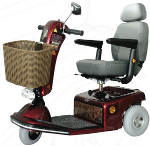 It is not uncommon for a senior to have difficulty walking and getting around. Around the home, it is possible that not being able to walk for an extended period of time isn’t all that big of an issue and in many cases, a walker or rollator will offset these difficulties. However, going places like the grocery store, shopping mall, or even walking around might not be possible, so many seniors use mobility scooters.
It is not uncommon for a senior to have difficulty walking and getting around. Around the home, it is possible that not being able to walk for an extended period of time isn’t all that big of an issue and in many cases, a walker or rollator will offset these difficulties. However, going places like the grocery store, shopping mall, or even walking around might not be possible, so many seniors use mobility scooters.
Mobility scooters are one of the most common types of mobility vehicles, which allow a senior to effortlessly get around. Many are able to travel over 10 miles per charge and some can travel even further on a single charge, with a range of over 30 miles. There are many different types of mobility scooters, but they can typically be divided into three distinct categories; Travel Scooters, Heavy Duty Scooters, and Traditional Scooters.
Travel Scooters are very popular, because they are designed to be easily transported. They can be taken apart into several pieces, all of which are light enough for the average senior to lift, with the heaviest piece often weighing less than 30 pounds. This means that the travel scooter can be dissembled quickly and placed in the trunk or back seat of a car, without the need of a special scooter lift.
While travel scooters can be very convenient, their lightweight comes at the cost of features. They also often have a shorter range than other scooters, are not quite as durable, and will typically have a lower weight capacity than a non-travel scooter.
Where travel scooter are made with transportability in mind, heavy duty scooters are designed to be driven almost anywhere. As a result, they are very heavy and will very likely require a scooter lift to transport, but they preform very well over almost all terrains. They have a much higher weight capacity than other mobility scooters, offer reinforced bumpers, a higher ground clearance, a larger more comfortable chair, and larger wheels. They also have a much larger range and top speed, with some heavy duty scooters able to travel over 10 miles per hour.
Many people who spend a great deal of time outdoors will go with a heavy duty scooter and they can be not only very practical, but also a good deal of fun to drive. However, they tend to have a rather large turning radius, which means that they wont do as well in very tight quarters, such as in a living room. This means that a heavy duty scooter is an excellent choice for outdoors and public areas, like the grocery store, but might not always be the best choice for use inside the home.
The last type of scooter is the traditional scooter and this is sort of a catch all category. If it isn’t a travel scooter or a heavy duty scooter, then it is a traditional scooter. They are more durable than travel scooters, yet not quite as durable as a heavy duty scooter. Most traditional scooters can be easily taken apart, but the individual pieces will not be as easy to handle.
For a senior, or anyone who has difficulty walking for that matter, a mobility scooter can greatly improve accessibility. These devices provide a cost effective alternative to electric wheelchairs and are very easy to use.
Choosing the Right Type of Mobility Vehicle Lift
Saturday, December 5th, 2009
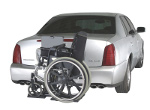 Vehicle Lifts are used to make it easier to transport a wheelchair or mobility scooter. When considering what type of vehicle lift to use, there are several factors that should be taken into account, including what type of mobility vehicle is being transported and what type of vehicle is being used. These factors will often help narrow down the options that are available to the wheelchair user, making it much simpler to select the right wheelchair lift.
Vehicle Lifts are used to make it easier to transport a wheelchair or mobility scooter. When considering what type of vehicle lift to use, there are several factors that should be taken into account, including what type of mobility vehicle is being transported and what type of vehicle is being used. These factors will often help narrow down the options that are available to the wheelchair user, making it much simpler to select the right wheelchair lift.
What Type of Mobility Vehicle is Being Transported
The type of mobility vehicle that is being transported is often the biggest factor that helps determine what type of vehicle lift to use. There are many different models of mobility vehicles, but they can usually be classified as manual wheelchairs, electric wheelchairs, and mobility scooters.
In the case of transporting a manual wheelchair, most people will simply fold it up and put it in their trunk. However, since manual wheelchairs can be rather heavy, sometimes lifting them into the back of the car can be difficult. Also, there is often simply not enough room in the car, so an external wheelchair lift is used. These are usually not motorized and attach to the hitch of a vehicle.
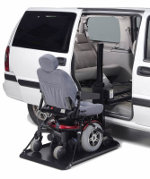 Of course, if you have a mobility scooter or an electric wheelchair, a manual wheelchair lift will not work. Instead, you would need to invest in a motorized wheelchair lift. In some cases, electric wheelchair carriers and mobility scooters carriers can be used interchangeably, but this is not always the case.
Of course, if you have a mobility scooter or an electric wheelchair, a manual wheelchair lift will not work. Instead, you would need to invest in a motorized wheelchair lift. In some cases, electric wheelchair carriers and mobility scooters carriers can be used interchangeably, but this is not always the case.
For example, often instead of a full platform, mobility scooter lifts will use a lift that has metal tracks, which are only large enough for the wheels of the scooter to fit into. When loading the scooter, the wheels will be driven into the tracks, which support the entire weight of the device. For three wheel scooters, the lift will have three tracks and for four wheeled scooters, there would be two tracks.
Some other lifts will have automatic hold down arms, which engage as the lift is being raised and hold the scooter in place without the need for tie-down straps. The automatic hold down arm works, because of the longer design of the mobility scooter, making contact with the floor portion where the use rests their feet. However, most electric wheelchairs will not work with this type of lift.
When in doubt, if the lift is labeled as an Universal Lift this means it will work with both electric wheelchairs and mobility scooters. Otherwise, it will often only work with one or the other.
What Type of Vehicle is Doing the Transporting
 The type of vehicle that will transporting the mobility vehicle is also important.
The type of vehicle that will transporting the mobility vehicle is also important.
For example, those that wished to use a passenger car have fewer options than those with a van or SUV. Typically, the only option would be a hitch mounted lift or a crane lift. The hitch mounted lift is simply inserted onto the vehicles hitch and either has its own battery pack or uses the vehicles power. Crane lifts are installed into the trunk of the car and simply hoist the wheelchair off the ground in the same manner a crane lifts a heavy load to the top of a building. One feature to look out for when shopping for crane lifts is Powered Rotation, which means the crane’s arm can be completely controlled electronically.
Those who have a SUV or van can also use the hitch mounted lift or the crane lift, but internal wheelchair lifts are also an option. These use a small platform that extends from the vehicle, allows the scooter or wheelchair to be driven onto the platform, then retracts, storing the wheelchair inside of the vehicle. These are most popular with vans, as by removing one of the rows of seats, the scooter can be stored directly behind the drives seat. In SUVs, internal lifts are used in the rear trunk area.
Those with trucks also have a few options and can of course use the crane or hitch mounted options described above. There are also several specially made truck lifts that are designed to lift the scooter off of the ground and into the bed of the pickup truck.
Where You Live or Where You Plan on Traveling to
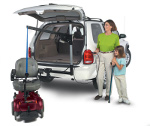 Yet another factor that helps determine what type of wheelchair lift is right, is where the person lives or where they plan on using the lift. For example, those who live in an area that gets a great deal of rain, snow, or other inclement weather, would probably want to go with a internal wheelchair lift. This way the wheelchair or scooter will be stored safely out of the weather.
Yet another factor that helps determine what type of wheelchair lift is right, is where the person lives or where they plan on using the lift. For example, those who live in an area that gets a great deal of rain, snow, or other inclement weather, would probably want to go with a internal wheelchair lift. This way the wheelchair or scooter will be stored safely out of the weather.
However, those who live in a more moderate climate would be able to use a hitch mounted wheelchair lift that stores the wheelchair outside of the vehicle. However, it is still usually recommended to invest in a cover for the wheelchair or scooter, to protect against sudden storms or road debris.